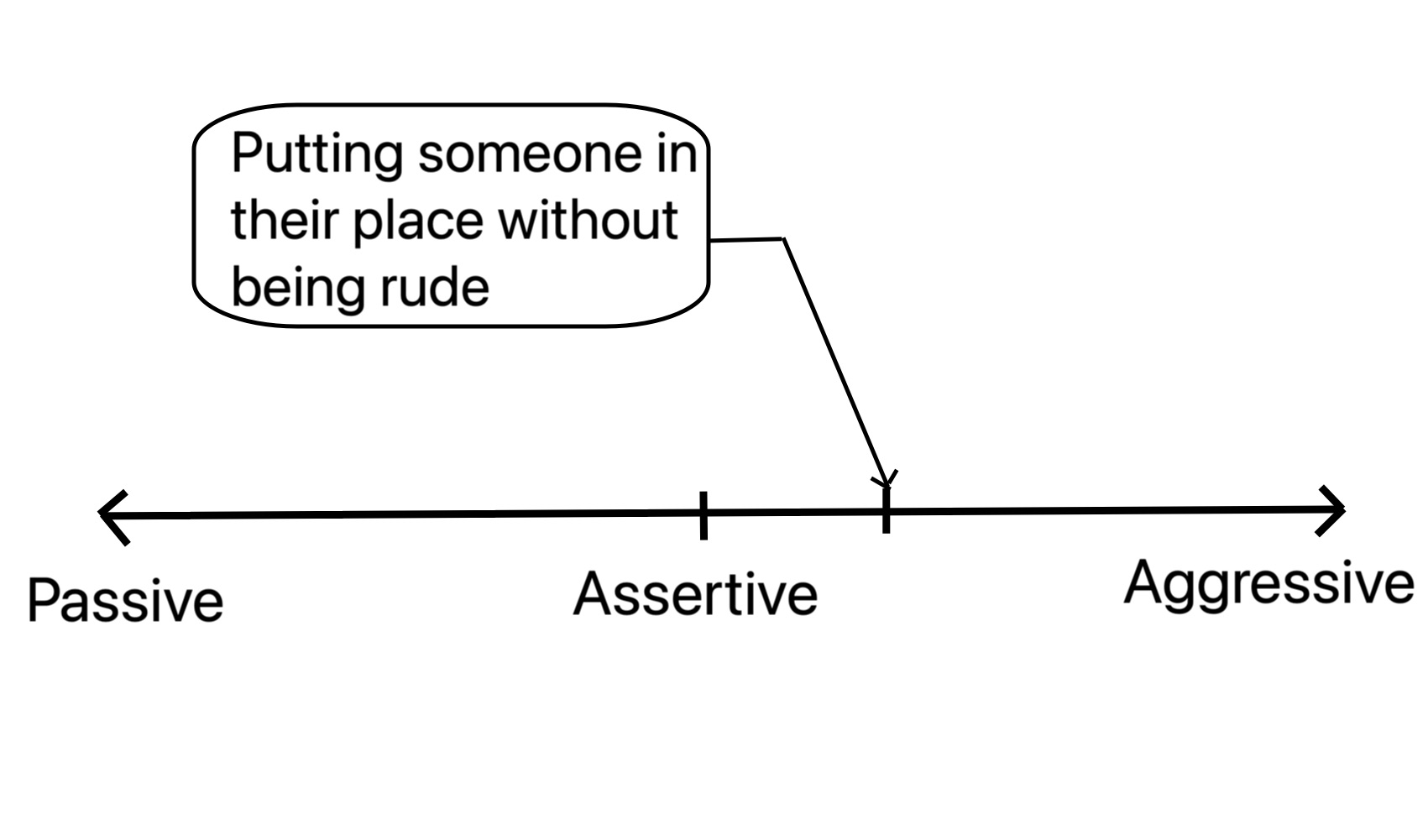If you badly need to put someone in their place, you’ve probably been a victim of verbal aggression. Examples of verbal aggression include:
- Put-downs
- Hateful criticisms
- Mockery
- Sarcasm
- Judging
- Crude remarks
- Talking in a condescending tone
- Yelling
- Offensive language
- Threats
- Violations of rights, space, and boundaries
All these rude behaviors make you feel attacked. Since humans are wired to maintain their status and respect, you feel the need to defend yourself. You feel the need to put the aggressor in their place.

But, as you’ve probably experienced, doing that usually escalates the situation and worsens things for both parties. Far from being able to maintain your dignity, you come across as aggressive and emotional.
Hence, knowing how to put someone in their place without escalating the situation is a critical social skill.
Communication styles
When someone behaves aggressively towards you, you have three ways in which you can respond:
1. Aggressively
It’s meeting fire with fire. You respond with the same or even greater level of aggression. Responding to aggression with aggression works because people, like many other animals, are sensitive to dominance and intimidation.
Responding to aggression with aggression communicates:
“I’ll harm you if you harm me.”
No one wants to be harmed. So they back off.
But chances are, they won’t back off because they’re aggressive too. Or they wouldn’t have harmed you in the first place. Instead, they’ll attack back. So, responding to aggression with aggression usually escalates the situation.
2. Passively
Responding passively to aggression is doing nothing about it. Passive or submissive people find it hard to stand up for themselves. So, they tend to get walked all over.
They don’t like being stepped on, like any other human, but don’t dare to do anything about it. Consequently, they suffer considerable blows to their self-esteem and are likely to become passive-aggressive.
As you can see, these communication styles are nothing but the ‘fight’ and ‘flight’ responses to social threats. When faced with a social threat, most people behave either aggressively or passively.
3. Assertively
There’s a third response to aggression that very few people can execute. Someone who responds assertively stands up for themselves without stepping on the rights of others.
This isn’t easy to do and requires a lot of awareness, practice, and self-control.

An assertive person has no desire for revenge. Their only goal is to safeguard their rights. An aggressive person, in contrast, seeks revenge by intimidation and putting the other person in their place.
Someone who wants to put the other person in their place without being rude wants revenge, but in a safe way. They want to teach a lesson to their aggressor, but in a way that doesn’t escalate the situation.
They may not want to give others a taste of their own medicine (aggression), but they do want to leave a bitter taste in their mouths.
They want to tone down their aggression just enough so it can still leave an impact. And the other person can barely do anything about it because the impact is low but not low enough to not pinch them.
Of course, this is even harder to execute than assertiveness and requires God-level social skills.
The art of non-aggressive aggressiveness
Before you decide to do anything about someone being aggressive, you want to be sure that they’re indeed being aggressive. Sometimes there’s no doubt they’re violating you, but other times, it’s unclear.
People who’ve been traumatized, for example, tend to over-detect social threats. In other words, they’re prone to assume aggression where there is none.
If you’re reasonably sure the other person is being a jerk, and you want to put them in their place without escalation, here are some ideas:
1. Ignore completely
This tactic works best with strangers and people you don’t care that much about. We do get hurt when random strangers are mean to us. People care about people in general. But, of course, you won’t care as much about a stranger as you care about a family member.
A stranger who’s rude to you isn’t worth your time and attention most of the time. By ignoring them entirely and acting like they don’t exist, you immediately put them in their place.
This tactic also works on people close to you but can be too risky in that scenario. You don’t want to give them the impression that you don’t care about their existence.
2. Stay calm
If you get angry, you’re likely to be aggressive. If you feel afraid, you’re likely to be passive. To be assertive and subtly put them in their place, you have to control your emotions.
I know people keep advising to keep calm when provoked. It’s sound advice but hard to execute. We need to play some mind games. I’ll give you a mental model to help you practice this:
First, understand that getting you all emotional and worked up is likely a manipulation tactic. The person trying to stir your emotions is likely trying to control you. If they make you feel the way they want to make you feel, they can make you do what they want you to do.
Second, some people like narcissists and sociopaths may simply get a kick out of getting an emotional reaction out of you.
Imagine them having the remote control of your emotions, sitting on the couch, changing channels, and getting entertained by your emotional reactions while you’re the TV.
You’re a human and not a TV. It’s time to snatch that remote control from them so they can’t push your buttons.
3. Filter out their emotions
The reason why it’s so hard to avoid being aggressive when provoked is because aggression, especially verbal aggression, is laden with emotions.
We react emotionally to emotional assaults.
For instance, you may get confused if someone says something condescending to you without that condescending tone. You’d probably debate whether or not they were being condescending.
But something neutral said in a condescending tone almost always comes across as condescending. It’s because it’s the tone and other non-verbal cues that carry the emotions and stir emotions in us.
So, mentally filtering out the other person’s emotions can be an excellent way to not respond aggressively to a provocation.
One way to put someone in their place politely is to address the message rather than how it is delivered. If you completely ignore how it’s delivered and find logical flaws in the content of the message, you’ll put the other person in their place.
By saying things like “I disagree” or “That’s your opinion” in an emotionally flat tone, you remove the emotional assault and address the facts.
There’s nothing they can do about you disagreeing with them. It’s not an attack so they can’t attack back. It leaves a bitter taste in their mouth that they can do nothing about.
4. Use wit and comebacks
Comebacks are effective because they’re unexpected and shock the aggressor. They allow you to hit back without escalating the situation. Since the aggressor doesn’t know how to react to your comeback, they’re put in their place.
Some people are naturally witty and come up with good comebacks. You can listen to them and learn how they think.
The guy in the clip below knew he was likely going to be roasted on the show. He admitted in an interview that he studied comebacks and comedy to prepare himself. As a result, he totally annihilated the host:
You have to be careful with comebacks as they can be demeaning and therefore, aggressive. Unless you’re fighting fire with fire, of course. All is fair in love and war.
